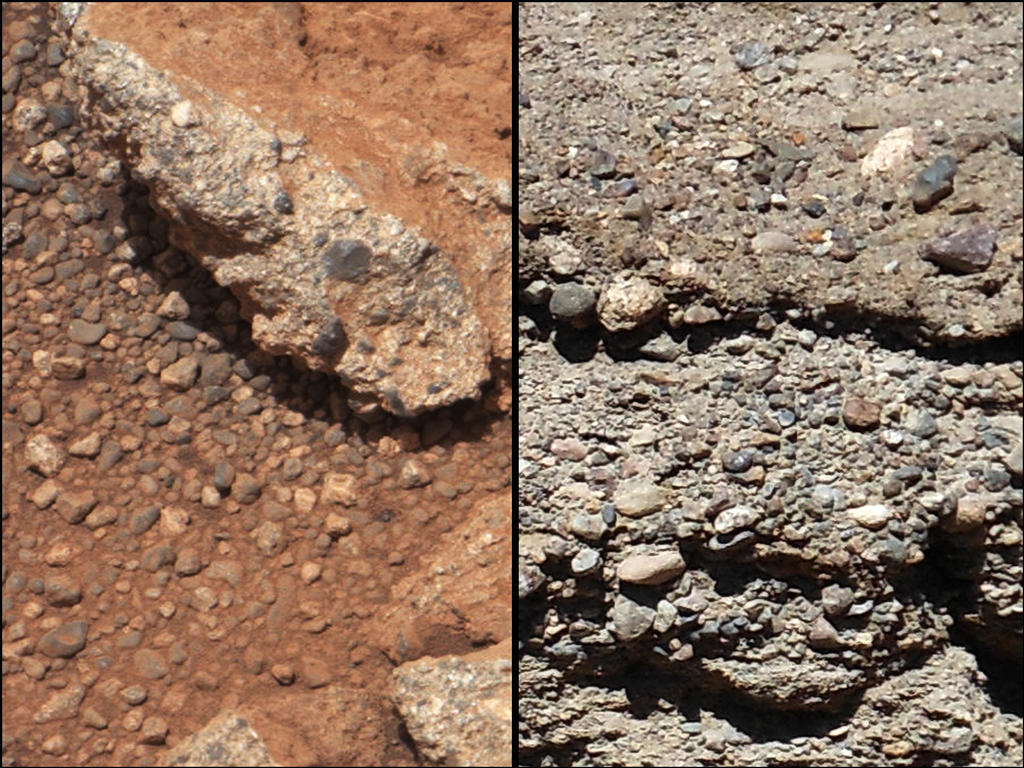Stunning Evidence of Ancient Riverbed on Mars
September 28, 2012
Rounded pebbles photographed by Curiosity, NASA’s newest Mars rover, are direct evidence that a deep, fast-moving stream of water once flowed across Gale Crater, the rover’s landing site, scientists announced on September 27. Curiosity scientists said the pebbles had been eroded and smoothed out while being carried down a stream or river that ran for perhaps 25 miles (40 kilometers) across the Martian surface. “This is the first time we’re actually seeing water-transported gravel on Mars. This is a transition from speculation about the size of streambed material to direct observation of it,” said science co-investigator William Dietrich of the University of California, Berkeley. The pebbles are too big to have been blown to the site by the wind. By comparing the size and shape of the Martian pebbles to pebbles found in streambeds on Earth, Curiosity scientists determined that the water on Mars was moving about 3 feet (0.9 meter) per second with a depth somewhere between ankle and hip deep. The largest and most advanced robotic laboratory ever sent to another planet, Curiosity is designed to answer one of the most important questions in planetary science–whether Mars is, or ever has been, capable of supporting microbial life.

The rounded pebbles found on Mars (left) are similar to rocks transported and cemented together by water on Earth (right). Some of the rocks are several inches (centimeters) wide. (NASA/JPL-Caltech/MSSS and PSI)
The pebbles were found in two tilted conglomerates named Hottah and Link. Conglomerates are rounded pebbles embedded in a fine-grained material. Scientists described Hottah as looking like a “jack-hammered … slab of city sidewalk.” The conglomerates lie about halfway between the north rim of Gale Crater and Mount Sharp, the rover’s ultimate destination. From the many channels found at the base of the rim, the scientists determined that the water flows may have lasted for thousands, even millions of years. “A long-flowing stream can be a habitable environment,” said Mars Science Laboratory Project Scientist John Grotzinger of the California Institute of Technology in Pasadena.
Scientists have long believed that water apparently has existed near the surface of Mars over part of the planet’s history. Evidence collected by spacecraft has suggested that liquid water apparently carved Mars’s large channels, smaller valleys, and young gullies. Scientists also concluded that vast quantities of ice exist within about 3 feet (1 meter) of the surface near the south pole and perhaps near the north pole. They also theorized that water is probably present beneath the surface today, kept liquid by Mars’s internal heat.

The water in the ancient streambed found by Curiosity likely flowed into Gale Crater from a channel called Peace Vallis. As the water flowed over the rim of the crater, it created an alluvial fan, a fan-shaped deposit of layered gravels, sands, silts, and other materials. Curiosity's landing site is marked by a cross in the black oval. (NASA/JPL-Caltech/UofA)
Additional World Book articles:
- Mars Exploration Rover Mission
- Mars Pathfinder
- Phoenix (spacecraft)
- Space exploration (Probes to Mars)
- The Search for Water on Mars (a Special Report)


